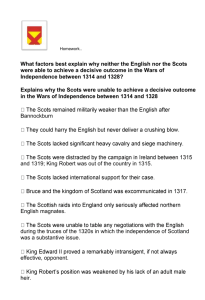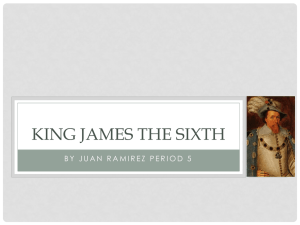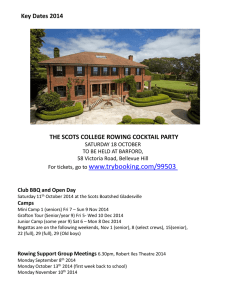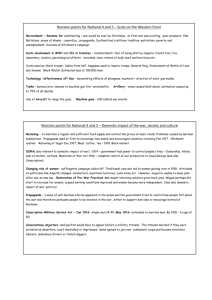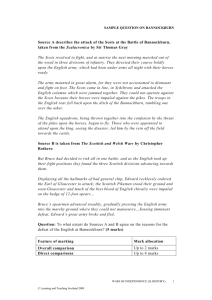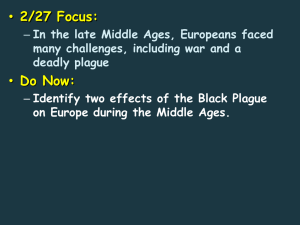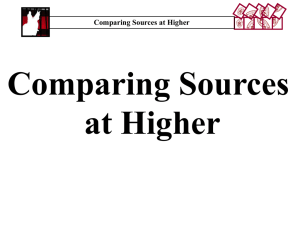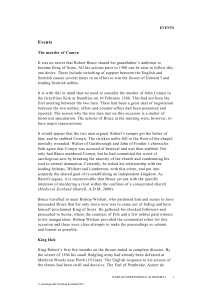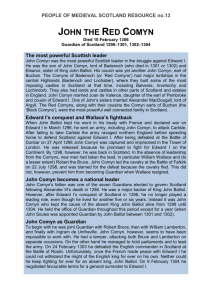The rise and triumph of Robert Bruce: Historical debate
advertisement
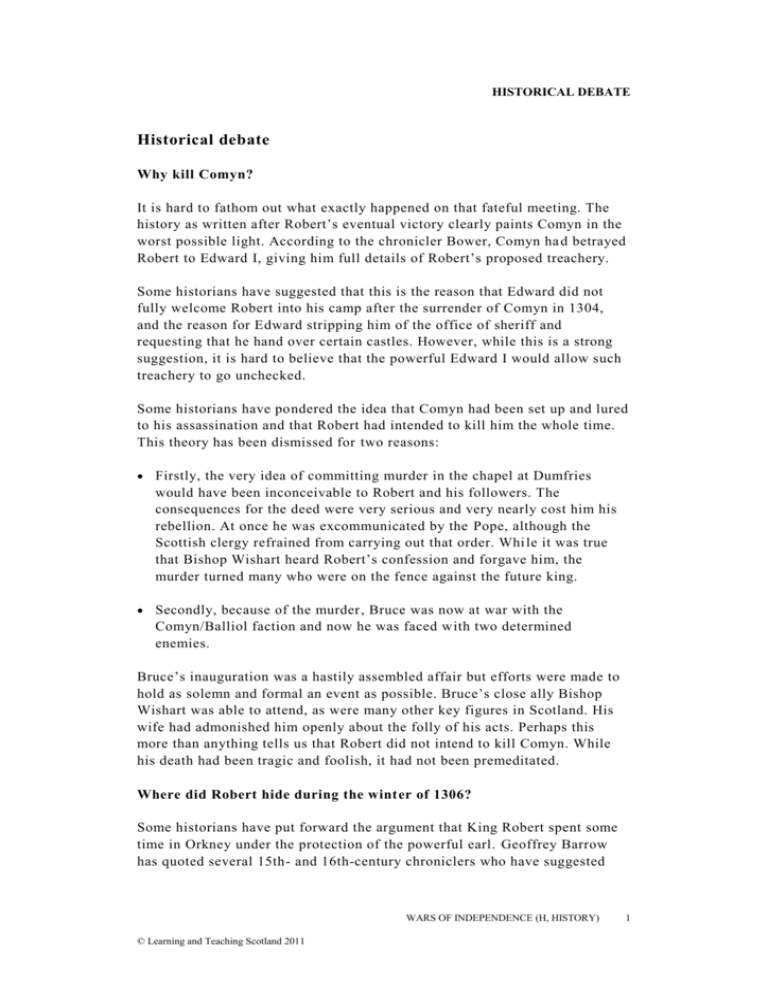
HISTORICAL DEBATE Historical debate Why kill Comyn? It is hard to fathom out what exactly happened on that fateful meeting. The history as written after Robert’s eventual victory clearly paints Comyn in the worst possible light. According to the chronicler Bower, Comyn ha d betrayed Robert to Edward I, giving him full details of Robert’s proposed treachery. Some historians have suggested that this is the reason that Edward did not fully welcome Robert into his camp after the surrender of Comyn in 1304, and the reason for Edward stripping him of the office of sheriff and requesting that he hand over certain castles. However, while this is a strong suggestion, it is hard to believe that the powerful Edward I would allow such treachery to go unchecked. Some historians have pondered the idea that Comyn had been set up and lured to his assassination and that Robert had intended to kill him the whole time. This theory has been dismissed for two reasons: Firstly, the very idea of committing murder in the chapel at Dumfries would have been inconceivable to Robert and his followers. The consequences for the deed were very serious and very nearly cost him his rebellion. At once he was excommunicated by the Pope, although the Scottish clergy refrained from carrying out that order. Whi le it was true that Bishop Wishart heard Robert’s confession and forgave him, the murder turned many who were on the fence against the future king. Secondly, because of the murder, Bruce was now at war with the Comyn/Balliol faction and now he was faced with two determined enemies. Bruce’s inauguration was a hastily assembled affair but efforts were made to hold as solemn and formal an event as possible. Bruce’s close ally Bishop Wishart was able to attend, as were many other key figures in Scotland. His wife had admonished him openly about the folly of his acts. Perhaps this more than anything tells us that Robert did not intend to kill Comyn. While his death had been tragic and foolish, it had not been premeditated. Where did Robert hide during the winter of 1306? Some historians have put forward the argument that King Robert spent some time in Orkney under the protection of the powerful earl. Geoffrey Barrow has quoted several 15th- and 16th-century chroniclers who have suggested WARS OF INDEPENDENCE (H, HISTORY) © Learning and Teaching Scotland 2011 1 HISTORICAL DEBATE that the king sought refuge in Norway itself but the most likely suggestion is that King Robert was constantly on the move, looking to gather support from the Western Isles. Why did the Scots succeed at Bannockburn? The simple answer is that the Scots were better in battle. However, the simple answer is not enough to satisfy most historians. Most agree that the answer lies in two main areas: English failings and Scottish successes. Scottish successes Leadership The Scots were led by a dedicated and well -motivated group of friends and allies. King Robert’s captains were veterans of the wars and had the loyalty and love of their men. Robert was unquestionably an able general. His use of terrain, personal courage and choice of tactics were flawless. Others, like Randolph, fought on foot next to the men of their schiltro n, they led by example. All of the commanders knew their roles. They knew the aims of the day: to continually push forward and hem in the superior English army in the confines of the Carse. In essence the Scots were better led than the disorganised English. Discipline The Scots troops were highly disciplined. Each man knew his place in the schiltron and, unlike under Wallace at Falkirk, they had trained at moving and staying in formation. Even during the thundero us charges of the English knights, the Scots pike men stayed shoulder to shoulder with their comrades in arms. Morale The events of the previous day had done much to boost the morale of the Scots army. News of the defeat of the English squadrons under the command of Clifford and Hereford had inspired the men. However, more inspiring had been the tale of the duel between their king and Henry de Bohun. When the Scots prepared for battle in the morning, they were well rested; they had eaten a good breakfast and were confident that their king could win. Planning It is often said that Robert had not intended to fight at Bannockburn, but he did not discount the possibility that he may have to fight and planned accordingly. The use of the holes or ‘pottes’ in the ground on the old Roman road is often cited as an anti-cavalry measure. However, in reality they were too obvious and easily spotted by the English forces. But if we consider that King Robert was playing a much more subtle game, then it is possible to 2 WARS OF INDEPENDENCE (H, HISTORY) © Learning and Teaching Scotland 2011 HISTORICAL DEBATE believe that the Scots king had hoped to encourage the English to fight on the Carse. King Robert did everything he could to push his opposite number to fight on the ground of his choosing, including digging these easily spotted defences. This shows a clear mind and a devious plan: King Robert may not have decided on the eve of the battle to actually give fight, but he certainly had planned for that possibility and discovered a way to neutralise the English advantage of superior numbers. English weaknesses Leadership In stark contrast to the Scots camp, the English leadership was at odds with itself. The king, Edward II, took almost no interest in the planning of the battle, and left that to his lieutenants. It is also true that there was considerable discord among the leading English nobles. Many of the greater magnates and usual leaders of the army had been overlooked by Edward during this campaign. Instead he interfered in the chain of command and promoted lesser men, some suggest his lovers, to positions of command, thereby alienating a good many of the more able leaders. Thus the leadership of the English host was anything but cohesive, and rarely acted together for the common good. Discipline The knights, who made such a potentially important element o f the army, were notoriously difficult to keep in check. They were always looking to the glory of the charge, and failing to recognise the importance of the other elements of the army. Consequently, the English at Bannockburn lacked sufficient discipline to engage King Robert’s formations. As the battle began, the archers were in the centre of the force, and had no way of attacking the Scots, as they had successfully done at Falkirk. Despite their failure to penetrate the schiltrons on the previous day, the knights charged headlong into the Scots with disastrous results. The English king fought bravely in the battle, but was unable to lead his men or exert any discipline on his knights. Morale For many in the English forces, the night before the battle was particularly stressful. The entire army had moved during the night to take up new positions on the Carse. Thus, few had any sleep; many had to forage far and wide to find enough food and shelter for all the men. Local farmhouses had to be stripped of their doors so that temporary bridges could be built to get the horses across the burn. When the army had finally got into position they were forced to stand guard during what was left of the night, in case the Scots tried a night attack on the camp, or slipped away into darkness. Worse were the stories of the previous day’s defeats, being retold around the campfires. The news was very bleak, and many considered the Scots king invincible. Unlike WARS OF INDEPENDENCE (H, HISTORY) © Learning and Teaching Scotland 2011 3 HISTORICAL DEBATE the Scots, these men were not fighting for their homes or a cause they could believe in. Many were Irish and Welsh and had little love for their king. When the morning came they had only a quick cold meal before the battle began. It is little wonder that for the majority of the infantry their heart wasn’t in the fight. Planning There had been little thought as to the deployment of the troops prior to the battle. None of the English commanders had believed that the Scots would actually deploy for the battle. During the night manoeuvre, the vanguard of the army had been forced to merge into a long ragged line of all the cavalry divisions. There was no thought about how the rest of the army would be deployed or used. Indeed, the archers were in such a position that they could not effectively be used because they would end up shooting the knights in the back. The majority of the army couldn’t even fit on the battlefield and remained on the far bank of the burn. Essentially, the English underestimated the Scots at Bannockburn and paid the price for their initial disdain of King Robert’s pike men. Why was Edward II unable to defend northern England from the Scots? The later years of the war are portrayed as the ineffectiveness of the English to contain King Robert. With ease, his forces were able to come south and cross the border. The northern counties were ravaged, crops burned, farmers killed, livestock and other goods stolen, and the English king seemed unable to prevent it. The reasons for this are twofold. Firstly, the wars had effectively bankrupted the Exchequer. It became increasingly hard for the monarchy to fund expensive expeditions to the north. There was little chance of real success; it had now become readily apparent that the subduing of Scotland was an unobtainable goal. Added to this was the lack of booty to entice the nobility to join in. The lack of money meant that any armies in the north would have to be provisioned and funded by the north and several years of famine up to 1318 meant that at least two expeditions to Scotland had to be cancelled. This all meant that the northern counties were essentially on their own for the most part. Secondly, King Robert was an exceptional strategist. The few times that Edward managed to raise a suitable force to confront the Scots, he found himself unable to bring King Robert to battle. Twice, Edward led a sizeable army north towards Berwick and twice he failed to entice Robert to battle. Instead the Scottish king marched his forces south into the northern counties and laid waste to all he could find. Both times, Edward was forced to abandon 4 WARS OF INDEPENDENCE (H, HISTORY) © Learning and Teaching Scotland 2011 HISTORICAL DEBATE his campaign to return south and protect England from the Scots armies. After the humiliating failure of the 1322 campaign, Edward could no longer rely upon his southern barons to raise such an army again. What was the purpose of the Declaration of Arbroath? Traditionalist historians suggest that the declaration was a patriotic expression of popular support for the Wars of Independence and King Robert by the combined freemen of the kingdom of Scotland. Some have even gone as far to suggest that the passages on replacing Robert if he failed to live up to his duties represent some of the earliest written ideas of a constitutional monarchy. Many have compared the Scots Declaration of Arbroath to the American Declaration of Independence, some going as far as to suggest that the earlier inspired the latter. Yet how true is this? Certainly the declaration is an impressive document. It is a rousing and inspiring denunciation of English foreign politics and has often been quoted. But was this the simple purpose of the letter at the time, or is that what it has come to mean to us, many centuries later? The first thing to bear in mind is that the Declaration of Arbroath was a letter to the Pope ordered by the king. There was also the very rea l threat of King Robert’s excommunication hanging over his head since the murder of Comyn in 1306. Thus the declaration should be seen in this context. The second thing to remember is that not all the signatories to the declaration would have been aware of the contents of the letter; indeed, most would not have been present at the writing of the document. In fact, many would have been requested to send their seals to the king’s chancellor so that they could be added to the letter in order to highlight its significance. If this is true, why would King Robert feel it so important to have such a show of unity from his nobility? Was it for the benefit of the Pope, to demonstrate that his usurpation of the throne was seen as legitimate in Scotland? But there is also another possibility, that in 1320 the political situation in Scotland was far from as stable as traditionalists would have us believe. This was demonstrated by the ‘Soules Conspiracy’ led by William Soules, a member of the Comyn faction by birth. He was a possible heir to the Scottish throne, and had attempted to assassinate the king only a few months after the Declaration of Arbroath. The actual goal of the assassins is unclear, but demonstrates that Robert had worries about the support he had within his realm. Some historians have put forward the idea that the conspiracy may have been linked to the presence of Edward Balliol, son of John Balliol, at the court of Edward II. Perhaps William Soules was a front for Edward Balliol, who had maintained contact with those disinherited by Bruce. It is WARS OF INDEPENDENCE (H, HISTORY) © Learning and Teaching Scotland 2011 5 HISTORICAL DEBATE possible that the declaration was, therefore, a test of loyalty from his barons. Some of those whose seals appear on the document had supported the English up until 1314. In fact, several of the names that appear on it were to be charged with treason later in 1320. As possible support to this theory, Edward Balliol did invade Scotland alongside supporters following Bruce’s death in 1332. Clearly, Bruce continued to face factional discontent even after the Battle of Bannockburn. 6 WARS OF INDEPENDENCE (H, HISTORY) © Learning and Teaching Scotland 2011
